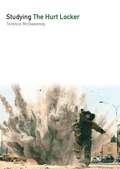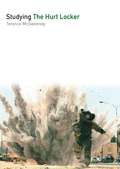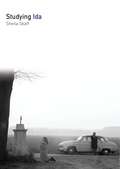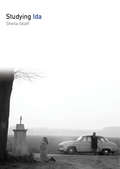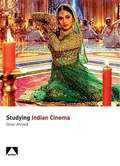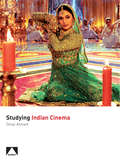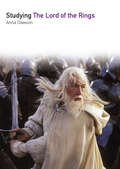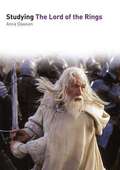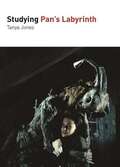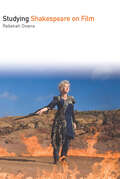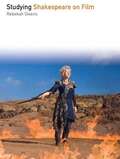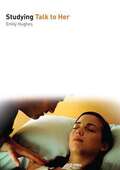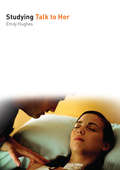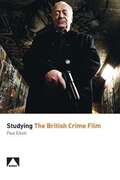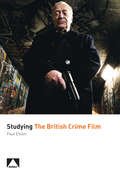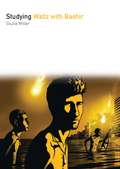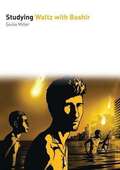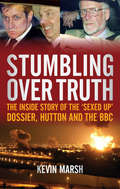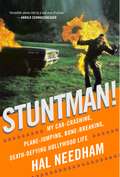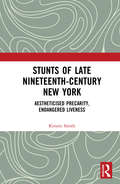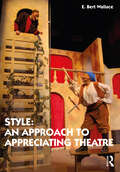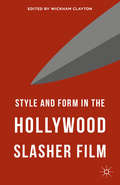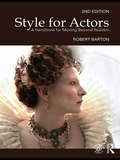- Table View
- List View
Studying The Hurt Locker (Studying Films)
by Terence McSweeneyIn this vibrant and dynamic book-length study drawing on a broad tapestry of research, Terence McSweeney offers an exploration of The Hurt Locker (2009), its stylistic and narrative devices, its cultural impact, its reception, and its relationship to the genre of the war film. McSweeney places the film in a richly textured historical, political, and industrial context, arguing that The Hurt Locker is part of a long tradition of films about American wars that play a considerable role in how audiences come to understand the conflicts that they depict. Thus, films about a nation’s wars are never “only a movie” but rather should be considered a cultural battleground themselves on which a war of representation is waged.
Studying The Hurt Locker (Studying Films)
by Terence McSweeneyIn this vibrant and dynamic book-length study drawing on a broad tapestry of research, Terence McSweeney offers an exploration of The Hurt Locker (2009), its stylistic and narrative devices, its cultural impact, its reception, and its relationship to the genre of the war film. McSweeney places the film in a richly textured historical, political, and industrial context, arguing that The Hurt Locker is part of a long tradition of films about American wars that play a considerable role in how audiences come to understand the conflicts that they depict. Thus, films about a nation’s wars are never “only a movie” but rather should be considered a cultural battleground themselves on which a war of representation is waged.
Studying Ida (Studying Films)
by Sheila SkaffPaweł Pawlikowski’s 2013 film Ida was exceptionally warmly received in the United States, culminating in the Academy Award for Film Not in the English Language, but it was not without controversy. Sheila Skaff’s introduction to the film explains the historical setting, including the violence that took place in the Polish countryside during World War II and was not exposed for sixty years, and provides political and cultural analysis to aid the reader in understanding the film’s setting and narrative. Skaff also touches on the influence of the film on current events in Poland, where censorship of it by an increasingly nationalist government has polarized the country. It also situates Ida within the contexts of Polish and world film history. Scene-by-scene analysis is accompanied in each chapter by background information that gives context to the aesthetic and narrative choices made by the director.
Studying Ida (Studying Films)
by Sheila SkaffPaweł Pawlikowski’s 2013 film Ida was exceptionally warmly received in the United States, culminating in the Academy Award for Film Not in the English Language, but it was not without controversy. Sheila Skaff’s introduction to the film explains the historical setting, including the violence that took place in the Polish countryside during World War II and was not exposed for sixty years, and provides political and cultural analysis to aid the reader in understanding the film’s setting and narrative. Skaff also touches on the influence of the film on current events in Poland, where censorship of it by an increasingly nationalist government has polarized the country. It also situates Ida within the contexts of Polish and world film history. Scene-by-scene analysis is accompanied in each chapter by background information that gives context to the aesthetic and narrative choices made by the director.
Studying Indian Cinema (Auteur)
by Omar AhmedThis book traces the historical evolution of Indian cinema through a number of key decades. The book is made up of 14 chapters with each chapter focusing on one key film, the chosen films analysed in their wider social, political and historical context whilst a concerted engagement with various ideological strands that underpin each film is also evident. In addition to exploring the films in their wider contexts, the author analyses selected sequences through the conceptual framework common to both film and media studies. This includes a consideration of narrative, genre, representation, audience and mise-en-scene. The case studies run chronologically from Awaara (The Vagabond, 1951) to The Elements Trilogy: Water (2005) and include films by such key figures as Satyajit Ray (The Lonely Wife), Ritwick Ghatak (Cloud Capped Star), Yash Chopra (The Wall) and Mira Nair (Salaam Bombay!).
Studying Indian Cinema (Auteur)
by Omar AhmedThis book traces the historical evolution of Indian cinema through a number of key decades. The book is made up of 14 chapters with each chapter focusing on one key film, the chosen films analysed in their wider social, political and historical context whilst a concerted engagement with various ideological strands that underpin each film is also evident. In addition to exploring the films in their wider contexts, the author analyses selected sequences through the conceptual framework common to both film and media studies. This includes a consideration of narrative, genre, representation, audience and mise-en-scene. The case studies run chronologically from Awaara (The Vagabond, 1951) to The Elements Trilogy: Water (2005) and include films by such key figures as Satyajit Ray (The Lonely Wife), Ritwick Ghatak (Cloud Capped Star), Yash Chopra (The Wall) and Mira Nair (Salaam Bombay!).
Studying The Lord of the Rings (Studying Films)
by Anna DawsonUnquestionably the first cinematic phenomenon of the twenty-first century, Peter Jackson's trilogy was a project of enormous artistic vision and financial risk. It is also a rich text for those studying film and media, perhaps for the first time. Studying The Lord of the Rings is the first book to consider the films in these terms, looking in turn at each of the major concepts: their complex origins and narrative structure; issues of representation masculinity, femininity and race; their generic patterns (to which genre do the films belong?) and thematic concerns; their industrial context from theatrical release to DVD extended editions; film language fusing classical mise-en-scène with cutting-edge technological practice. The aim throughout is to highlight critical debates and key terms, to relate these to the texts and to explore their stylistic and cultural impact. This Student Edition (a previously published Instructor's Edition is available) brings the story up to date with reflections on The Hobbit films.
Studying The Lord of the Rings (Studying Films)
by Anna DawsonUnquestionably the first cinematic phenomenon of the twenty-first century, Peter Jackson's trilogy was a project of enormous artistic vision and financial risk. It is also a rich text for those studying film and media, perhaps for the first time. Studying The Lord of the Rings is the first book to consider the films in these terms, looking in turn at each of the major concepts: their complex origins and narrative structure; issues of representation masculinity, femininity and race; their generic patterns (to which genre do the films belong?) and thematic concerns; their industrial context from theatrical release to DVD extended editions; film language fusing classical mise-en-scène with cutting-edge technological practice. The aim throughout is to highlight critical debates and key terms, to relate these to the texts and to explore their stylistic and cultural impact. This Student Edition (a previously published Instructor's Edition is available) brings the story up to date with reflections on The Hobbit films.
Studying Pan's Labyrinth (Studying Films)
by Tanya JonesPan's Labyrinth (2006) is a film of extraordinary technical achievement and intense emotional impact, garnering acclaim from both critics and audiences alike. Such a rich cinematic text demands close scrutiny and comprehensive study. This volume guides the reader through a detailed analysis of the film, concentrating on the generation of meaning for the viewer. The book maps technical choices and how they capture human experience and political conflict. It also details the processes of production, distribution, and exhibition. Specific examples from a range of film texts enable a vivid grasp of technical vocabulary, therefore providing readers with the tools to analyze other films as well.
Studying Shakespeare on Film (Studying Films)
by Rebekah OwensAimed at newcomers to literature and film, this book is a guide for the analysis of Shakespeare on film. Starting with an introduction to the main challenge faced by any director—the early-modern language—there follows exemplars for examining how that challenge is met using as case studies twelve films most often used in classroom teaching, including Romeo and Juliet, Macbeth, and The Tempest.The first chapter explores how a director can tell the story in a setting that embraces the expectations of realism in cinema, but still pays homage to the theatrical origins of the work. The second chapter discusses films in which the setting provides a visual analogy with the preoccupations of the story, but not at the expense of Shakespeare's language. The third chapter extends this to show how some films use recent history as a setting, adding a further layer of meaning to the story from the cultural resonances associated with that historical past. These films also rely on an assumption that Shakespeare is so well-known as to form a distinctive, easily recognized brand in the cinema marketplace. Thus, his work can be reimagined in completely different genres such as those films that are the subject of the final chapter.
Studying Shakespeare on Film (Studying Films)
by Rebekah OwensAimed at newcomers to literature and film, this book is a guide for the analysis of Shakespeare on film. Starting with an introduction to the main challenge faced by any director—the early-modern language—there follows exemplars for examining how that challenge is met using as case studies twelve films most often used in classroom teaching, including Romeo and Juliet, Macbeth, and The Tempest.The first chapter explores how a director can tell the story in a setting that embraces the expectations of realism in cinema, but still pays homage to the theatrical origins of the work. The second chapter discusses films in which the setting provides a visual analogy with the preoccupations of the story, but not at the expense of Shakespeare's language. The third chapter extends this to show how some films use recent history as a setting, adding a further layer of meaning to the story from the cultural resonances associated with that historical past. These films also rely on an assumption that Shakespeare is so well-known as to form a distinctive, easily recognized brand in the cinema marketplace. Thus, his work can be reimagined in completely different genres such as those films that are the subject of the final chapter.
Studying Talk to Her (Studying Films)
by Emily HughesTalk to Her (2002) is a hugely rich and interesting though ambiguous film that met with both popular success and critical acclaim. The film won an Oscar for best original screenplay and has been hailed by some critics as Pedro Almodóvar's masterpiece. Yet like most of Almodóvar's films, little is clear cut. The characters are complex and our affinity and empathy for them shifts throughout the film. In Studying Talk to Her, Emily Hughes provides an in-depth analysis of both the formal elements of the film (its narrative, genre, and auteur study) and the themes and issues it raises, discussing the social context of modern Spain and its old, traditional iconography; shifting attitudes towards gender; and, crucially, the film's uneasy, morally ambiguous depiction of rape and the spectator's reaction to it.
Studying Talk to Her (Studying Films)
by Emily HughesTalk to Her (2002) is a hugely rich and interesting though ambiguous film that met with both popular success and critical acclaim. The film won an Oscar for best original screenplay and has been hailed by some critics as Pedro Almodóvar's masterpiece. Yet like most of Almodóvar's films, little is clear cut. The characters are complex and our affinity and empathy for them shifts throughout the film. In Studying Talk to Her, Emily Hughes provides an in-depth analysis of both the formal elements of the film (its narrative, genre, and auteur study) and the themes and issues it raises, discussing the social context of modern Spain and its old, traditional iconography; shifting attitudes towards gender; and, crucially, the film's uneasy, morally ambiguous depiction of rape and the spectator's reaction to it.
Studying the British Crime Film (Studying British Cinema)
by Paul ElliottEver since its inception, British cinema has been obsessed with crime and the criminal. One of the first narrative films to be produced in Britain, the Hepworth's 1905 short Rescued by Rover, was a fast-paced, quick-edited tale of abduction and kidnap, and the first British sound film, Alfred Hitchcock's Blackmail (1930), centered on murder and criminal guilt. For a genre seemingly so important to the British cinematic character, there is little direct theoretical or historical work focused on it. The Britain of British cinema is often written about in terms of national history, ethnic diversity, or cultural tradition, yet very rarely in terms of its criminal tendencies and dark underbelly. This volume assumes that, to know how British cinema truly works, it is necessary to pull back the veneer of the costume piece, the historical drama, and the rom-com and glimpse at what is underneath. For every Brief Encounter (1945) there is a Brighton Rock (2010), for every Notting Hill (1999) there is a Long Good Friday (1980).
Studying the British Crime Film (Studying British Cinema)
by Paul ElliottEver since its inception, British cinema has been obsessed with crime and the criminal. One of the first narrative films to be produced in Britain, the Hepworth's 1905 short Rescued by Rover, was a fast-paced, quick-edited tale of abduction and kidnap, and the first British sound film, Alfred Hitchcock's Blackmail (1930), centered on murder and criminal guilt. For a genre seemingly so important to the British cinematic character, there is little direct theoretical or historical work focused on it. The Britain of British cinema is often written about in terms of national history, ethnic diversity, or cultural tradition, yet very rarely in terms of its criminal tendencies and dark underbelly. This volume assumes that, to know how British cinema truly works, it is necessary to pull back the veneer of the costume piece, the historical drama, and the rom-com and glimpse at what is underneath. For every Brief Encounter (1945) there is a Brighton Rock (2010), for every Notting Hill (1999) there is a Long Good Friday (1980).
Studying Waltz with Bashir (Studying Films)
by Giulia MillerOn its release in 2008, Ari Folman's animated documentary Waltz with Bashir was heralded as a brilliant and original exploration of trauma, and trauma's impact on memory and the recording of history. But it is surprising that although the film is seen through the eyes of one particular soldier, a viewpoint portrayed using highly experimental forms of animation, this has not prevented Waltz with Bashir from being regarded as both an "autobiographical" and "honest" account of the director's own experiences in the 1982 Lebanon war. In fact, the film won several documentary awards, and even those critics focusing on the representation of trauma suggest that this trauma must be authentic. In this sense, it is the documentary form rather than the animation that has had the most influence upon critics.As Studying Waltz with Bashir will show, it is the tension between the two forms that makes the film so complex and interesting, allowing for multiple themes and discourses to coexist, including Israel's role during the Lebanon War and the impact of trauma upon narrative, but also the representation of Holocaust memory and its role in the formation of Israeli identity. In addition to these themes that coexist by virtue of the film's unusual animated documentary format, Waltz with Bashir can also be discussed in relation to a broad range of contexts; for example, the representation of war in film, the history of Israeli Holocaust cinema, and recent trends in experimental animation, such as Richard Linklater's Waking Life (2001) and A Scanner Darkly (2006), as well as Folman's most recent live action/animation work The Congress (2013).
Studying Waltz with Bashir (Studying Films)
by Giulia MillerOn its release in 2008, Ari Folman's animated documentary Waltz with Bashir was heralded as a brilliant and original exploration of trauma, and trauma's impact on memory and the recording of history. But it is surprising that although the film is seen through the eyes of one particular soldier, a viewpoint portrayed using highly experimental forms of animation, this has not prevented Waltz with Bashir from being regarded as both an "autobiographical" and "honest" account of the director's own experiences in the 1982 Lebanon war. In fact, the film won several documentary awards, and even those critics focusing on the representation of trauma suggest that this trauma must be authentic. In this sense, it is the documentary form rather than the animation that has had the most influence upon critics.As Studying Waltz with Bashir will show, it is the tension between the two forms that makes the film so complex and interesting, allowing for multiple themes and discourses to coexist, including Israel's role during the Lebanon War and the impact of trauma upon narrative, but also the representation of Holocaust memory and its role in the formation of Israeli identity. In addition to these themes that coexist by virtue of the film's unusual animated documentary format, Waltz with Bashir can also be discussed in relation to a broad range of contexts; for example, the representation of war in film, the history of Israeli Holocaust cinema, and recent trends in experimental animation, such as Richard Linklater's Waking Life (2001) and A Scanner Darkly (2006), as well as Folman's most recent live action/animation work The Congress (2013).
Stumbling Over Truth: The Inside Story and the 'Sexed Up' Dossier, Hutton and the BBC
by Kevin MarshThe 2004 report of the Hutton Inquiry created today's BBC. It cost the corporation its Chairman and Director General and seemed to many to usher in an age of self-doubt and caution. It was also the end of the most extraordinary experiment in news management Britain has ever seen - the decade of Alastair Campbell, Tony Blair's spin doctor, charged with delivering what Peter Mandelson described as New Labour's mission to 'create the truth'. But Lord Hutton condemned the BBC and its journalism without hearing a single word from the man who put the 'sexed up' dossier story on the air: Today editor Kevin Marsh. Had Hutton done so, his conclusions would surely have been very different. Now outside the BBC, Marsh can tell for the first time the inside story of Andrew Gilligan's notorious 6.07 broadcast on the Today programme. He explains how he was certain the story of the 'sexed up' dossier was true, but also how Gilligan's 'flawed reporting' fatally damaged the BBC's case. And he tells of his growing disillusionment with the British media's aptitude and appetite for holding power to account - or even telling the truth. Stumbling Over Truth is an important book for anyone who wants to understand the toe-to-toe confrontations between Tony Blair's government and the BBC, and the fight to resist unremitting government attempts to manipulate the media.
Stuntman!: My Car-Crashing, Plane-Jumping, Bone-Breaking, Death-Defying Hollywood Life
by Hal NeedhamYep that's me, Hal Needham, on the cover doing a fire stunt. When you're on fire you don't dare breathe because if you do, you'll suck those flames right down your throat. I was Hollywood's highest paid stuntman so I should know. I wrecked hundreds of cars, fell from tall buildings, got blown up, was dragged by horses, and along the way broke 56 bones, my back twice, punctured a lung and knocked out a few teeth...I hung upside down by my ankles under a bi-plane in The Spirit of St. Louis, jumped between galloping horses in Little Big Man, set a world record for a boat stunt on Gator, jumped a rocket powered pick-up truck across a canal for a GM commercial, was the first human to test the car airbag-and taught John Wayne how to really throw a movie punch. Life also got exciting outside of the movie business. I had my Ferrari stolen right from under my nose, flew in a twin-engine Cessna with a passed out pilot, rescued the cast and crew from a Russian invasion in Czechoslovakia, and once took six flight attendants on a date. I owned the Skoal-Bandit NASCAR race team, the sound-barrier breaking Budweiser Rocket Car and drove a souped-up, fake ambulance in a "little" cross-country race called The Cannonball Run, which became the movie I directed by the same name. Oh yeah, I also directed Smokey and the Bandit, Hooper and several other action/comedy movies that I liked a bunch. I was a sharecropper's son from the hills of Arkansas who became a Hollywood stuntman. That journey was a tough row to hoe. I continually risked my life but that was the career I chose. I was never late to the set and did whatever I had to do to get the job done. Hollywood's not all sunglasses and autographs. Let me tell you a few stories...
Stunts of Late Nineteenth-Century New York: Aestheticised Precarity, Endangered Liveness
by Kirstin SmithStunts of Late Nineteenth- Century New York: Aestheticised Precarity, Endangered Liveness examines the emergence of stunts in the media, politics, sport and art of New York at the turn of the twentieth century. This book investigates stunts in sport, media and politics, demonstrating how these risky performances tapped into anxieties and fantasies concerning work, freedom, gendered/ raced/ classed bodies and the commodifi cation of human life. Its case studies examine bridge jumping, extreme walking contests, stunt journalists such as Nellie Bly, and cycling feats including Annie Londonderry’s round- the- world venture. Supported by extensive archival research and Performance Studies theorisations of precarity, liveness and surrogation, Smith theorises an under- examined form which is still prevalent in art, politics and commerce, to show what stunts reveal about value, risk and human life. Suitable for scholars and practitioners across a range of subjects, from Performance Studies to gender studies, to media studies, Stunts of Late Nineteenth- Century New York explores how stunts turned everyday precarity into a spectacle.
Stunts of Late Nineteenth-Century New York: Aestheticised Precarity, Endangered Liveness
by Kirstin SmithStunts of Late Nineteenth- Century New York: Aestheticised Precarity, Endangered Liveness examines the emergence of stunts in the media, politics, sport and art of New York at the turn of the twentieth century. This book investigates stunts in sport, media and politics, demonstrating how these risky performances tapped into anxieties and fantasies concerning work, freedom, gendered/ raced/ classed bodies and the commodifi cation of human life. Its case studies examine bridge jumping, extreme walking contests, stunt journalists such as Nellie Bly, and cycling feats including Annie Londonderry’s round- the- world venture. Supported by extensive archival research and Performance Studies theorisations of precarity, liveness and surrogation, Smith theorises an under- examined form which is still prevalent in art, politics and commerce, to show what stunts reveal about value, risk and human life. Suitable for scholars and practitioners across a range of subjects, from Performance Studies to gender studies, to media studies, Stunts of Late Nineteenth- Century New York explores how stunts turned everyday precarity into a spectacle.
Style: An Approach To Appreciating Theatre
by E. Bert WallaceStyle: An Approach to Appreciating Theatre offers brief, readable chapters about the basics of theatre as a starting point for discussion, and provides new adaptations of classic plays that are both accessible to students learning about theatre and fit for production. In this text, style is the word used to describe the various ways in which theatre is done in real space and time by humans in the physical presence of other humans. The book uses style, the "liveness" of theatre that makes it distinct from literature or history, as a lens to see how playwrights, directors, designers, and actors bring scripts to life on stage. Rather than focusing on theatre history or literary script analysis, it emphasizes actual theatrical production through examples and explores playscripts illustrating four theatrical styles: Realism, Theatricalism, Expressionism, and Classicism. Susan Glaspells Realistic play Trifles is presented as written, while The Insect Play by the Brothers apek, The Hairy Ape by Eugene ONeill, and Antigone by Sophocles are original, full-length adaptions. Style: An Approach to Appreciating Theatre is the perfect resource for students of Theatre Appreciation, Introduction to Theatre, Theatrical Design, and Stagecraft courses.
Style and Form in the Hollywood Slasher Film
by Wickham ClaytonStyle and Form in the Hollywood Slasher Film fills a broad scholastic gap by analysing the elements of narrative and stylistic construction of films in the slasher subgenre of horror that have been produced and/or distributed in the Hollywood studio system from its initial boom in the late 1970s to the present.
Style: An Approach to Appreciating Theatre
by E. Bert WallaceStyle: An Approach to Appreciating Theatre offers brief, readable chapters about the basics of theatre as a starting point for discussion, and provides new adaptations of classic plays that are both accessible to students learning about theatre and fit for production. In this text, style is the word used to describe the various ways in which theatre is done in real space and time by humans in the physical presence of other humans. The book uses style, the "liveness" of theatre that makes it distinct from literature or history, as a lens to see how playwrights, directors, designers, and actors bring scripts to life on stage. Rather than focusing on theatre history or literary script analysis, it emphasizes actual theatrical production through examples and explores playscripts illustrating four theatrical styles: Realism, Theatricalism, Expressionism, and Classicism. Susan Glaspells Realistic play Trifles is presented as written, while The Insect Play by the Brothers apek, The Hairy Ape by Eugene ONeill, and Antigone by Sophocles are original, full-length adaptions. Style: An Approach to Appreciating Theatre is the perfect resource for students of Theatre Appreciation, Introduction to Theatre, Theatrical Design, and Stagecraft courses.
Style For Actors: A Handbook for Moving Beyond Realism
by Robert Barton"Style is a journey from tourist to native. It is living in the world of the play, not just visiting it." - from Chapter One Anyone who has ever struggled with capes, fans, swords, doublets and crinolines should make Style for Actors 2nd Edition their constant companion. Robert Barton has completely updated his award winning handbook for the 21st century with contemporary references and up-to-date illustrations. This is the definitive guide to roles in historical drama. The past is a foreign country, and this outstanding book is concerned with exploring it from the actor’s point of view. Specific guides range from Greek, Elizabethan, Restoration and Georgian theatre to more contemporary stylings, including Futurism, Surrealism and Postmodernism. Barton takes great care to present the actor with the roles and genres that will most commonly confront them. His analysis moves from entire genres to specific scenes and characters. A huge resource of nearly 150 practical exercises helps a newfound understanding of style to make the leap from page to performance.
